+ データを開く
データを開く
- 基本情報
基本情報
| 登録情報 | データベース: PDB / ID: 8ebt | ||||||||||||
|---|---|---|---|---|---|---|---|---|---|---|---|---|---|
| タイトル | XPA repositioning Core7 of TFIIH relative to XPC-DNA lesion (Cy5) | ||||||||||||
 要素 要素 |
| ||||||||||||
 キーワード キーワード | DNA BINDING PROTEIN/DNA / protein-DNA complex / DNA BINDING PROTEIN-DNA complex | ||||||||||||
| 機能・相同性 |  機能・相同性情報 機能・相同性情報nucleotide-excision repair factor 1 complex / nucleotide-excision repair involved in interstrand cross-link repair / XPC complex / nucleotide-excision repair, DNA damage recognition / 9+2 motile cilium / core TFIIH complex portion of holo TFIIH complex / MMXD complex / photoreceptor connecting cilium / heterotrimeric G-protein binding / Cytosolic iron-sulfur cluster assembly ...nucleotide-excision repair factor 1 complex / nucleotide-excision repair involved in interstrand cross-link repair / XPC complex / nucleotide-excision repair, DNA damage recognition / 9+2 motile cilium / core TFIIH complex portion of holo TFIIH complex / MMXD complex / photoreceptor connecting cilium / heterotrimeric G-protein binding / Cytosolic iron-sulfur cluster assembly / transcription export complex 2 / central nervous system myelin formation / response to auditory stimulus / positive regulation of mitotic recombination / hair follicle maturation / hair cell differentiation / nucleotide-excision repair, preincision complex assembly / nuclear pore nuclear basket / CAK-ERCC2 complex / UV protection / embryonic cleavage / G protein-coupled receptor internalization / UV-damage excision repair / transcription factor TFIIH core complex / transcription factor TFIIH holo complex / transcription preinitiation complex / RNA Polymerase I Transcription Termination / nuclear thyroid hormone receptor binding / regulation of mitotic cell cycle phase transition / hematopoietic stem cell proliferation / intercellular bridge / regulation of cyclin-dependent protein serine/threonine kinase activity / spinal cord development / RNA Pol II CTD phosphorylation and interaction with CE during HIV infection / RNA Pol II CTD phosphorylation and interaction with CE / Formation of the Early Elongation Complex / Formation of the HIV-1 Early Elongation Complex / mRNA Capping / bone mineralization / HIV Transcription Initiation / RNA Polymerase II HIV Promoter Escape / Transcription of the HIV genome / RNA Polymerase II Promoter Escape / RNA Polymerase II Transcription Pre-Initiation And Promoter Opening / RNA Polymerase II Transcription Initiation / RNA Polymerase II Transcription Initiation And Promoter Clearance / erythrocyte maturation / RNA Polymerase I Transcription Initiation / centriole replication / transcription by RNA polymerase I / ATPase activator activity / transcription factor TFIID complex / intrinsic apoptotic signaling pathway by p53 class mediator / protein localization to nucleus / RNA polymerase II general transcription initiation factor activity / hematopoietic stem cell differentiation / transcription elongation by RNA polymerase I / Tat-mediated elongation of the HIV-1 transcript / mRNA transport / Formation of HIV-1 elongation complex containing HIV-1 Tat / embryonic organ development / transcription-coupled nucleotide-excision repair / Formation of HIV elongation complex in the absence of HIV Tat / SUMOylation of DNA damage response and repair proteins / RNA Polymerase II Transcription Elongation / Formation of RNA Pol II elongation complex / response to UV / DNA helicase activity / Loss of Nlp from mitotic centrosomes / Loss of proteins required for interphase microtubule organization from the centrosome / Recruitment of mitotic centrosome proteins and complexes / Recruitment of NuMA to mitotic centrosomes / RNA Polymerase II Pre-transcription Events / Anchoring of the basal body to the plasma membrane / centriole / hormone-mediated signaling pathway / AURKA Activation by TPX2 / extracellular matrix organization / maturation of SSU-rRNA from tricistronic rRNA transcript (SSU-rRNA, 5.8S rRNA, LSU-rRNA) / insulin-like growth factor receptor signaling pathway / ciliary basal body / post-embryonic development / regulation of cytokinesis / chromosome segregation / determination of adult lifespan / nucleotide-excision repair / RNA Polymerase I Promoter Escape / TP53 Regulates Transcription of DNA Repair Genes / transcription initiation at RNA polymerase II promoter / DNA Damage Recognition in GG-NER / G-protein beta/gamma-subunit complex binding / NoRC negatively regulates rRNA expression / base-excision repair / multicellular organism growth / Dual Incision in GG-NER / Transcription-Coupled Nucleotide Excision Repair (TC-NER) / cellular response to gamma radiation / Formation of TC-NER Pre-Incision Complex / Formation of Incision Complex in GG-NER / spindle 類似検索 - 分子機能 | ||||||||||||
| 生物種 |  Homo sapiens (ヒト) Homo sapiens (ヒト)synthetic construct (人工物) | ||||||||||||
| 手法 | 電子顕微鏡法 / 単粒子再構成法 / クライオ電子顕微鏡法 / 解像度: 3.9 Å | ||||||||||||
 データ登録者 データ登録者 | Kim, J. / Yang, W. | ||||||||||||
| 資金援助 |  米国, 米国,  日本, 3件 日本, 3件
| ||||||||||||
 引用 引用 |  ジャーナル: Nature / 年: 2023 ジャーナル: Nature / 年: 2023タイトル: Lesion recognition by XPC, TFIIH and XPA in DNA excision repair. 著者: Jinseok Kim / Chia-Lung Li / Xuemin Chen / Yanxiang Cui / Filip M Golebiowski / Huaibin Wang / Fumio Hanaoka / Kaoru Sugasawa / Wei Yang /     要旨: Nucleotide excision repair removes DNA lesions caused by ultraviolet light, cisplatin-like compounds and bulky adducts. After initial recognition by XPC in global genome repair or a stalled RNA ...Nucleotide excision repair removes DNA lesions caused by ultraviolet light, cisplatin-like compounds and bulky adducts. After initial recognition by XPC in global genome repair or a stalled RNA polymerase in transcription-coupled repair, damaged DNA is transferred to the seven-subunit TFIIH core complex (Core7) for verification and dual incisions by the XPF and XPG nucleases. Structures capturing lesion recognition by the yeast XPC homologue Rad4 and TFIIH in transcription initiation or DNA repair have been separately reported. How two different lesion recognition pathways converge and how the XPB and XPD helicases of Core7 move the DNA lesion for verification are unclear. Here we report on structures revealing DNA lesion recognition by human XPC and DNA lesion hand-off from XPC to Core7 and XPA. XPA, which binds between XPB and XPD, kinks the DNA duplex and shifts XPC and the DNA lesion by nearly a helical turn relative to Core7. The DNA lesion is thus positioned outside of Core7, as would occur with RNA polymerase. XPB and XPD, which track the lesion-containing strand but translocate DNA in opposite directions, push and pull the lesion-containing strand into XPD for verification. | ||||||||||||
| 履歴 |
|
- 構造の表示
構造の表示
| 構造ビューア | 分子:  Molmil Molmil Jmol/JSmol Jmol/JSmol |
|---|
- ダウンロードとリンク
ダウンロードとリンク
- ダウンロード
ダウンロード
| PDBx/mmCIF形式 |  8ebt.cif.gz 8ebt.cif.gz | 624 KB | 表示 |  PDBx/mmCIF形式 PDBx/mmCIF形式 |
|---|---|---|---|---|
| PDB形式 |  pdb8ebt.ent.gz pdb8ebt.ent.gz | 490.9 KB | 表示 |  PDB形式 PDB形式 |
| PDBx/mmJSON形式 |  8ebt.json.gz 8ebt.json.gz | ツリー表示 |  PDBx/mmJSON形式 PDBx/mmJSON形式 | |
| その他 |  その他のダウンロード その他のダウンロード |
-検証レポート
| 文書・要旨 |  8ebt_validation.pdf.gz 8ebt_validation.pdf.gz | 1.1 MB | 表示 |  wwPDB検証レポート wwPDB検証レポート |
|---|---|---|---|---|
| 文書・詳細版 |  8ebt_full_validation.pdf.gz 8ebt_full_validation.pdf.gz | 1.1 MB | 表示 | |
| XML形式データ |  8ebt_validation.xml.gz 8ebt_validation.xml.gz | 92.6 KB | 表示 | |
| CIF形式データ |  8ebt_validation.cif.gz 8ebt_validation.cif.gz | 143.6 KB | 表示 | |
| アーカイブディレクトリ |  https://data.pdbj.org/pub/pdb/validation_reports/eb/8ebt https://data.pdbj.org/pub/pdb/validation_reports/eb/8ebt ftp://data.pdbj.org/pub/pdb/validation_reports/eb/8ebt ftp://data.pdbj.org/pub/pdb/validation_reports/eb/8ebt | HTTPS FTP |
-関連構造データ
| 関連構造データ |  27997MC 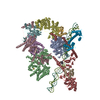 8ebsC 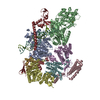 8ebuC 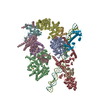 8ebvC 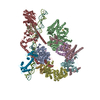 8ebwC 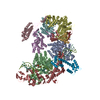 8ebxC 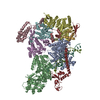 8ebyC M: このデータのモデリングに利用したマップデータ C: 同じ文献を引用 ( |
|---|---|
| 類似構造データ | 類似検索 - 機能・相同性  F&H 検索 F&H 検索 |
- リンク
リンク
- 集合体
集合体
| 登録構造単位 | 
|
|---|---|
| 1 |
|
- 要素
要素
-General transcription and DNA repair factor IIH helicase subunit ... , 2種, 2分子 AB
| #1: タンパク質 | 分子量: 69404.961 Da / 分子数: 1 / 由来タイプ: 組換発現 / 由来: (組換発現)  Homo sapiens (ヒト) Homo sapiens (ヒト)発現宿主:  |
|---|---|
| #2: タンパク質 | 分子量: 83582.250 Da / 分子数: 1 / 由来タイプ: 組換発現 / 由来: (組換発現)  Homo sapiens (ヒト) / 遺伝子: ERCC2, XPD, XPDC Homo sapiens (ヒト) / 遺伝子: ERCC2, XPD, XPDC発現宿主:  参照: UniProt: P18074, DNA helicase |
-General transcription factor IIH subunit ... , 5種, 5分子 CDEFG
| #3: タンパク質 | 分子量: 49569.930 Da / 分子数: 1 / 由来タイプ: 組換発現 / 由来: (組換発現)  Homo sapiens (ヒト) / 遺伝子: GTF2H1, BTF2 Homo sapiens (ヒト) / 遺伝子: GTF2H1, BTF2発現宿主:  参照: UniProt: P32780 |
|---|---|
| #4: タンパク質 | 分子量: 50432.066 Da / 分子数: 1 / 由来タイプ: 組換発現 / 由来: (組換発現)  Homo sapiens (ヒト) / 遺伝子: GTF2H4 Homo sapiens (ヒト) / 遺伝子: GTF2H4発現宿主:  参照: UniProt: Q92759 |
| #5: タンパク質 | 分子量: 42772.086 Da / 分子数: 1 / 由来タイプ: 組換発現 / 由来: (組換発現)  Homo sapiens (ヒト) / 遺伝子: GTF2H2, BTF2P44 Homo sapiens (ヒト) / 遺伝子: GTF2H2, BTF2P44発現宿主:  参照: UniProt: Q13888 |
| #6: タンパク質 | 分子量: 31788.727 Da / 分子数: 1 / 由来タイプ: 組換発現 / 由来: (組換発現)  Homo sapiens (ヒト) / 遺伝子: GTF2H3 Homo sapiens (ヒト) / 遺伝子: GTF2H3発現宿主:  参照: UniProt: Q13889 |
| #7: タンパク質 | 分子量: 7458.625 Da / 分子数: 1 / 由来タイプ: 組換発現 / 由来: (組換発現)  Homo sapiens (ヒト) / 遺伝子: GTF2H5, C6orf175, TTDA Homo sapiens (ヒト) / 遺伝子: GTF2H5, C6orf175, TTDA発現宿主:  参照: UniProt: Q6ZYL4 |
-DNA repair protein complementing XP- ... , 2種, 2分子 HK
| #8: タンパク質 | 分子量: 31552.350 Da / 分子数: 1 / 由来タイプ: 組換発現 / 由来: (組換発現)  Homo sapiens (ヒト) Homo sapiens (ヒト)発現宿主:  |
|---|---|
| #10: タンパク質 | 分子量: 20787.939 Da / 分子数: 1 / 由来タイプ: 組換発現 / 由来: (組換発現)  Homo sapiens (ヒト) / 遺伝子: XPA, XPAC Homo sapiens (ヒト) / 遺伝子: XPA, XPAC発現宿主:  参照: UniProt: P23025 |
-タンパク質 , 1種, 1分子 J
| #9: タンパク質 | 分子量: 8183.146 Da / 分子数: 1 / 由来タイプ: 組換発現 / 由来: (組換発現)  Homo sapiens (ヒト) / 遺伝子: CETN2, CALT, CEN2 Homo sapiens (ヒト) / 遺伝子: CETN2, CALT, CEN2発現宿主:  参照: UniProt: P41208 |
|---|
-DNA鎖 , 2種, 2分子 LM
| #11: DNA鎖 | 分子量: 13914.215 Da / 分子数: 1 / 由来タイプ: 合成 / 由来: (合成) synthetic construct (人工物) |
|---|---|
| #12: DNA鎖 | 分子量: 13707.808 Da / 分子数: 1 / 由来タイプ: 合成 / 由来: (合成) synthetic construct (人工物) |
-非ポリマー , 3種, 9分子 




| #13: 化合物 | ChemComp-SF4 / | ||
|---|---|---|---|
| #14: 化合物 | ChemComp-ZN / #15: 化合物 | |
-詳細
| 研究の焦点であるリガンドがあるか | Y |
|---|
-実験情報
-実験
| 実験 | 手法: 電子顕微鏡法 |
|---|---|
| EM実験 | 試料の集合状態: PARTICLE / 3次元再構成法: 単粒子再構成法 |
- 試料調製
試料調製
| 構成要素 | 名称: protein DNA complex / タイプ: COMPLEX / Entity ID: #1-#12 / 由来: RECOMBINANT | ||||||||||||||||||||||||||||||
|---|---|---|---|---|---|---|---|---|---|---|---|---|---|---|---|---|---|---|---|---|---|---|---|---|---|---|---|---|---|---|---|
| 分子量 | 値: 0.61 MDa / 実験値: NO | ||||||||||||||||||||||||||||||
| 由来(天然) | 生物種:  Homo sapiens (ヒト) Homo sapiens (ヒト) | ||||||||||||||||||||||||||||||
| 由来(組換発現) | 生物種:  | ||||||||||||||||||||||||||||||
| 緩衝液 | pH: 7.9 | ||||||||||||||||||||||||||||||
| 緩衝液成分 |
| ||||||||||||||||||||||||||||||
| 試料 | 濃度: 0.4 mg/ml / 包埋: NO / シャドウイング: NO / 染色: NO / 凍結: YES | ||||||||||||||||||||||||||||||
| 試料支持 | グリッドの材料: COPPER / グリッドのサイズ: 300 divisions/in. / グリッドのタイプ: Quantifoil R1.2/1.3 | ||||||||||||||||||||||||||||||
| 急速凍結 | 装置: FEI VITROBOT MARK IV / 凍結剤: ETHANE / 湿度: 100 % / 凍結前の試料温度: 277.15 K |
- 電子顕微鏡撮影
電子顕微鏡撮影
| 実験機器 |  モデル: Titan Krios / 画像提供: FEI Company |
|---|---|
| 顕微鏡 | モデル: FEI TITAN KRIOS |
| 電子銃 | 電子線源:  FIELD EMISSION GUN / 加速電圧: 300 kV / 照射モード: FLOOD BEAM FIELD EMISSION GUN / 加速電圧: 300 kV / 照射モード: FLOOD BEAM |
| 電子レンズ | モード: BRIGHT FIELD / 倍率(公称値): 105000 X / 最大 デフォーカス(公称値): 3000 nm / 最小 デフォーカス(公称値): 2000 nm / Cs: 2.7 mm / C2レンズ絞り径: 70 µm / アライメント法: COMA FREE |
| 試料ホルダ | 凍結剤: NITROGEN 試料ホルダーモデル: FEI TITAN KRIOS AUTOGRID HOLDER |
| 撮影 | 平均露光時間: 2.5 sec. / 電子線照射量: 54.1 e/Å2 / フィルム・検出器のモデル: GATAN K3 (6k x 4k) / 撮影したグリッド数: 1 / 実像数: 6243 |
- 解析
解析
| ソフトウェア | 名称: PHENIX / バージョン: 1.18.2_3874: / 分類: 精密化 | ||||||||||||||||||||||||||||||
|---|---|---|---|---|---|---|---|---|---|---|---|---|---|---|---|---|---|---|---|---|---|---|---|---|---|---|---|---|---|---|---|
| EMソフトウェア |
| ||||||||||||||||||||||||||||||
| CTF補正 | タイプ: PHASE FLIPPING AND AMPLITUDE CORRECTION | ||||||||||||||||||||||||||||||
| 粒子像の選択 | 選択した粒子像数: 1645921 | ||||||||||||||||||||||||||||||
| 対称性 | 点対称性: C1 (非対称) | ||||||||||||||||||||||||||||||
| 3次元再構成 | 解像度: 3.9 Å / 解像度の算出法: FSC 0.143 CUT-OFF / 粒子像の数: 173440 / アルゴリズム: FOURIER SPACE / 対称性のタイプ: POINT | ||||||||||||||||||||||||||||||
| 原子モデル構築 | プロトコル: AB INITIO MODEL / 空間: REAL / Target criteria: correlation coefficient | ||||||||||||||||||||||||||||||
| 原子モデル構築 | PDB-ID: 6RO4 Accession code: 6RO4 / Source name: PDB / タイプ: experimental model | ||||||||||||||||||||||||||||||
| 拘束条件 |
|
 ムービー
ムービー コントローラー
コントローラー











 PDBj
PDBj

















































